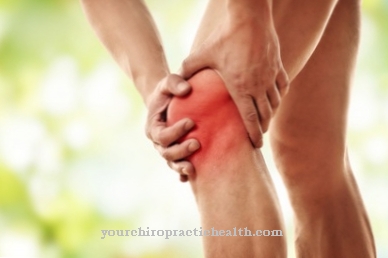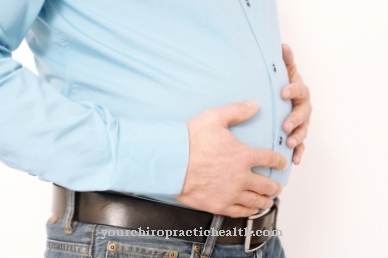A Swelling of the lymph nodes or Lymphadenopathy is, as the name suggests, a pathological swelling of the lymph nodes in the human body. Often the cervical lymph nodes are affected as part of a sore throat.
What is lymph node swelling?

Lymph nodes serve as a filter system for the so-called tissue water, which is also known as lymph fluid in technical terms. Similar to the blood system, the lymphatic system runs through the entire body.
The function of the lymph nodes is to strengthen the immune system and is therefore largely responsible for the defense against pathogens. It is therefore hardly surprising that the lymphocytes, i.e. the lymph cells, belong to the same cell category as the white blood cells. It is important to know that the lymph nodes are found everywhere on and in the body. The best known are found on the neck, in the organs and in the armpit or groin regions.
In a healthy state, the lymph nodes are about one centimeter in size. Swelling of the lymph nodes is common with infection and inflammation. In malignant and benign tumors, too, they often appear as a swelling.
causes
As a rule, lymph node swellings are harmless and only occur in the course of a simple inflammatory disease that will go away after a few days.
These include bacterial and viral infections, such as the flu or a common cold.
In some cases, however, swelling of the lymph nodes can also be caused by serious illnesses. These more serious diseases include benign but also malignant tumors such as lymph gland cancer and malignant lymphomas.
You can find your medication here
➔ Medicines against swelling of the lymph nodesDiseases with this symptom
- cold
- measles
- Tonsillar angina
- diphtheria
- Cat scratch disease
- Hodgkin's disease
- Cytomegaly
- HIV infection
- AIDS
- syphilis
- Chlamydia
- mumps
- Glandular Pfeiffer fever
- rubella
- tuberculosis
- Actinomycosis
- Lyme disease
- Sarcoid
Diagnosis & course
If swollen lymph nodes are found, an exact diagnosis of the underlying disease is important. The doctor clarifies the general state of health of the patient, collects the medical history and asks about accompanying complaints.
The doctor also checks whether lymph nodes are swollen in different parts of the body. A palpable examination of the left upper abdomen is used to determine whether there is an enlarged spleen, which occurs in some lymph node diseases. Depending on the suspected cause of the disease, ultrasound examinations, blood tests and biopsies (by taking lymph node tissue) as well as x-rays, magnetic resonance or computer tomographies are carried out.
When there is inflammation, lymph nodes have a firmer consistency and cause pain. Malignant lymph nodes are often hard, can hardly be moved and are not painful.
Complications
Lymph node swelling (lymphadenopathy) that has persisted for a long time is often treated surgically. This can damage tissue structures. Bruising, bleeding and secondary bleeding are also possible. Temporary symptoms of paralysis, numbness and other failures can occur.
Wound healing disorders as well as scarring and inflammation cannot be ruled out in connection with the surgical treatment of lymph node swelling. Allergic reactions can occur in varying degrees of severity. Functional or aesthetic impairments are relatively rare.
If the lymph node swelling persists over a long period of time, the skin is often overheated and reddened, and ultimately a purulent abscess. Lymphangitis occurs when the swollen lymph nodes become infected and inflamed. If the bacteria get into the bloodstream, it can lead to a life-threatening general infection that is associated with a high fever and chills. In the worst case, it can lead to fatal sepsis (blood poisoning).
It is also known that with frequently recurring symptoms, the destruction of the lymph vessels can lead to the formation of lymphedema. If there is painless lymph node swelling, which may be accompanied by a drop in performance, fever and weight loss, as well as night sweats, a tumorous disease of the lymph cells should also be considered. It cannot be ruled out that it is a Hodgkin lymphoma.
When should you go to the doctor?

Lymph node swelling occurs in different parts of the body. They are not always a cause for concern. Lymph node swelling can occur due to an acute cold. With colds and throat infections, the lymph nodes near the neck are often swollen. Inflamed tooth roots or abscesses in the jaw can also lead to swollen lymph glands. As the acute illness subsides, it should subside again. If this does not happen in the foreseeable future, the treating doctor should determine the causes.
For the medical professional, the location of the swollen lymph nodes is a clue as to which area of the body could be problematic. Many lymph node swellings are caused by an infection in the organism. These swellings do not always require a doctor's visit, provided they go down as the underlying disease subsides. If this does not happen, the patient should consult a doctor to be on the safe side. The first point of contact is usually the family doctor.
As long as the lymph nodes feel soft, painful and can be moved, a visit to the doctor is not absolutely necessary. Visits to the doctor are advisable if the symptoms of the disease worsen or last for an unusually long time. However, if the lymph nodes are hardened, can hardly be moved and remain without pain, the person concerned should think of a malignant disease. In this case, the immediate consultation of a specialist in internal diseases is advisable. Comprehensive research is necessary.
Doctors & therapists in your area
Treatment & Therapy
Determining the cause of swelling of the lymph nodes begins with a general medical history. This includes history, symptoms and a close examination of the swollen lymph nodes. The family doctor will ask questions about possible infections, such as colds, tonsillitis or flu. He will also try to determine how many and which lymph nodes are swollen and when they first appeared. Possible other previous illnesses and medication taken will also have to be investigated.
Afterwards, the doctor will usually feel the swollen lymph nodes carefully and check for appearance and pain stimulus. In particular, a deviating consistency (normally the lymph nodes are more flexible, elastic and soft) can provide further information about a possible cause of the lymph node swelling.
Furthermore, other lymph node areas should also be examined, as the lymph nodes of the organs may also be affected (e.g. lymph gland diseases of the spleen). To do this, the abdomen is scanned, fever and various blood values are measured.
Further examination options that can then define the exact cause are: X-ray examinations, computer and magnetic resonance tomography, ultrasound examination and tissue sampling.
Once the cause is found, appropriate individual treatment can be initiated. Since most lymph node swellings are harmless in nature, i.e. occur in the context of infections, no treatment is necessary as the enlarged lymph nodes swell again on their own. It may be useful to take antibiotics if you have a bacterial infection, but should definitely be discussed with your doctor beforehand. The same applies to lymph node swelling in the context of Pfeiffer's glandular fever and measles. Here, too, the medication should be determined with the doctor (so-called antivirals).
If the lymph nodes are swollen due to a tumor, clinical treatment with radiation and chemotherapy is essential for survival.
Aftercare
With regard to susceptibility to infection, follow-up care is often the same as prevention measures. Even with swollen lymph nodes, the main aim is to sustainably strengthen the body's immune system so that the organism can respond adequately to the attack of bacteria and viruses. Sufficient sleep and protection in cold weather are very important in this context.
To strengthen the immune system, saunas, which can cause a good hardening, are suitable. A balanced diet and exercise in the fresh air are also important factors in strengthening general well-being. Nicotine and alcohol increase susceptibility to infection and should therefore be reduced or avoided entirely.
Anyone prone to infections of the upper respiratory tract should ensure that the throat is optimally moistened as part of the follow-up care. The sliding ability of the pharynx mucosa thus achieved offers the bacteria that cause infections in this area a particularly small area to attack.
Outlook & forecast
In most cases, swelling of the lymph nodes also increases the size of the spleen and causes pain. After an operation, paralysis and numbness can occur for a short time. These usually disappear after a few days. Since scars can also develop during treatment, disorders or inflammations can develop there. The patient is therefore often dependent on taking antibiotics to avoid them.
If the lymph node swelling causes inflammation, bacteria can enter the blood. Due to the lymph node swelling, most patients also suffer from a general feeling of illness, from fever and from weight loss, so that it can also become underweight.
The swelling is usually treated causally, so that the treatment of the underlying disease is in the foreground. In most cases, the disease progresses positively if treatment is started early.
You can find your medication here
➔ Medicines against swelling of the lymph nodesYou can do that yourself
Ear infections, tonsillitis or colds usually manifest themselves with pain and swollen lymph nodes. Lymph nodes are elementary components of the human immune system and are found throughout the body. They are particularly easy to feel on the neck, under the armpits, behind the ears and on the back of the head. Lymphatic channels connect the lymph nodes and filter germs and other foreign substances out of the lymph fluid.
Simple home remedies can help with swelling of the lymph nodes caused by a cold. Massages can stimulate normal function and improve the removal of pathogens. The fingers are placed on the affected lymph nodes and gentle, circular movements are performed. The massage can be repeated several times a day. Warm compresses help reduce swelling by stimulating blood circulation. It is enough to put a washcloth soaked in warm water on the affected area for five to ten minutes. This can also be repeated several times a day.
Massaging with castor oil has a similar effect, because the oil has a decongestant and anti-inflammatory effect. Garlic has antibiotic properties. Crushing one or two toes and eating them with lemon juice can cause lymph nodes to swell. Garlic supports the healing process effectively. Externally, garlic oil helps against swelling of the lymph nodes. In addition to colds, serious illnesses such as cancer can also hide behind the swelling. If the lymph nodes have been swollen for several weeks, a doctor should be consulted.


.jpg)





















.jpg)



